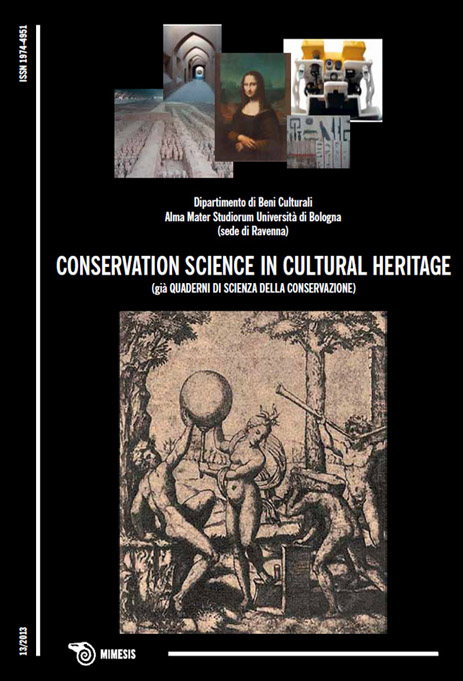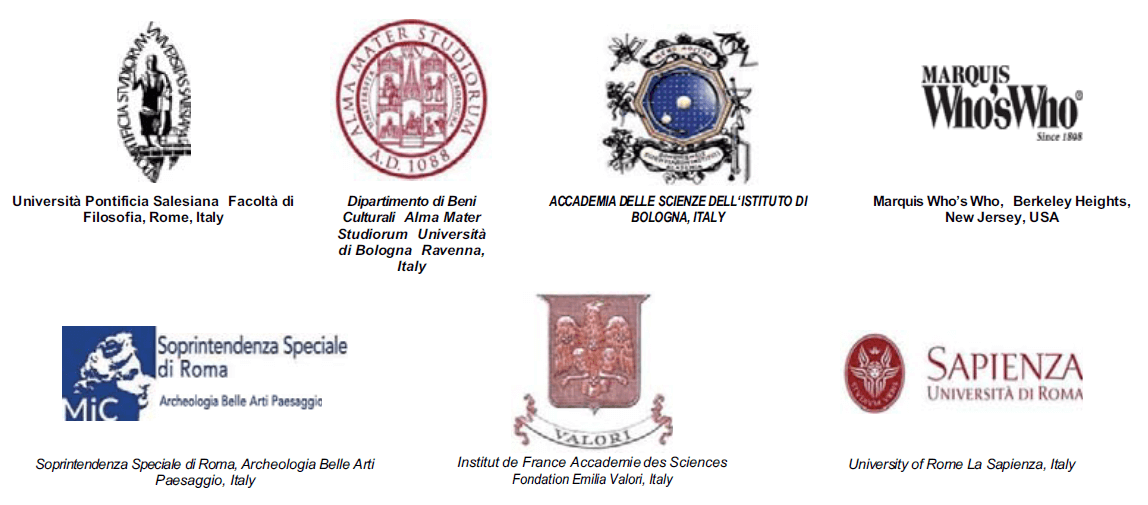Bioactive molecules: innovative contributions of biotechnology to the restoration of cultural heritage
DOI:
https://doi.org/10.6092/issn.1973-9494/4191Keywords:
biocleaning, proteases, removal of aged layers, conservative restorationAbstract
Summary
One of the first and most important steps during the conservative restoration of an artifact, is the action of cleaning, which enables the removal of organic layers such as animal glue or other protein mixtures that cover the original surface. Cleaning must be performed carefully and selectively, making a distinction between the different areas, so as not to cause irreversible damage to the surface of the object, and remove the deposits without acting directly on the original surface materials. In this study hydrolases isolated from marine organisms, whose peculiarity is to be active in a range of temperature between 4° C and 37° C, are proposed as an alternative to classic cleaning methods.
Riassunto
La pulitura, azione che permette la rimozione di strati soprammessi dalla superficie di un manufatto, è una delle prime e più importanti fasi attuate in interventi di restauro conservativo. Questa deve essere eseguita in modo da non causare danni irreversibili, quindi effettuata in modo selettivo, differenziando l’azione tra le diverse zone e rimuovendo in successione gli strati di deposito, senza interagire in modo diretto con i materiali originali della superficie. In questo studio sono state utilizzate nuove idrolasi isolate da organismi marini, la cui attività proteasica è stata saggiata in laboratorio, presentano la rilevante peculiarità è di essere attivi in un range di temperature compreso tra 4°C e 37°C e sono proposte come valida alternativa ai classici metodi di pulitura.
Résumé
Le nettoyage est l’action qui permet d’enlever les couches accumulées sur la surface d’un ouvrage, et c’est l’une des premières phases les plus importantes mises en œuvre dans les interventions de restauration-conservation. Le nettoyage doit faire en sorte de ne pas provoquer de dommages irréversibles : il est donc effectué de manière sélective en différenciant l’action suivant les zones, et en enlevant en succession les couches de dépôt sans interagir directement avec les matériaux originaux de la surface. Dans cette étude, on a utilisé de nouvelles hydrolases isolées d’organismes marins, dont l’activité protéasique a été testée en laboratoire. Elles présentent la particularité importante d’être actives dans un intervalle de températures compris entre4°Cet37°C. Elles sont proposées comme une alternative valable aux méthodes classiques de nettoyage.
Zusammenfassung
Die Säuberung, d.h. das Abtragen von abgelagerten Schichten auf einem Gegenstand, ist eine der ersten und wichtigsten Phasen bei konservativen Restaurierungsmaßnahmen. Sie muss so erfolgen, dass keine nicht wieder gutzumachenden Schäden entstehen, d.h. sie muss selektiv vorgenommen werden, durch unterschiedliche Bearbeitung der verschiedenen Zonen und aufeinanderfolgendes Abtragen der abgelagerten Schichten ohne direkt auf die originalen Materialien der Oberfläche einzuwirken. In dieser Studie wurden neue, von Meeresorganismen isolierte Hydrolasen eingesetzt, deren eiweißspaltende Wirkung im Labor getestet wurde. Diese haben die relevante Eigenschaft, dass sie in einem Temperaturbereich zwischen 4 und 37°C aktiv sind und eine gute Alternative zur den herkömmlichen Säuberungsmethoden bieten.
Resumen
La limpieza, acción que permite remover capas superpuestas de la superficie de una obra, es una de las primeras y más importantes fases llevadas a cabo en los trabajos de restauración conservativa. Dicha fase ha de ser realizada sin provocar daños irreversibles, por lo tanto es efectuada de forma selectiva, diferenciando el tipo de acción en las distintas zonas y quitando sucesivamente las capas de depósito, sin interaccionar directamente con los materiales originales de la superficie. En este estudio se han utilizado nuevas hidrolasas aisladas de organismos marinos, cuya actividad proteasa ha sido probada en laboratorio, con la importante peculiaridad de que permanecen activas en una franja de temperatura situada entre 4°C y 37°C y se proponen como una alternativa apropiada ante métodos clásicos de limpieza.
Резюме
Очистка, действие, которое позволяет удалить накопленные слои с поверхности артефакта, является одним из первых и наиболее важных шагов, применяемых при консервативной реставрации. Она должна производиться при недопущении необратимых повреждений, следовательно, ее проведение должно быть выборочным, при дифференциации вмешательств в различных зонах и, удаляя в последовательности слои накопления, не соприкасаясь напрямую с оригинальными материалами поверхности. В этом исследовании были использованы новые гидролазы, выделенные из морских организмов, протеазная активность которых была проанализирована в лаборатории, и которые имеют важную особенность, состоящую в том, что они могут быть активными в диапазоне температур от 4 ° С до 37 ° С и могут являться эффективной альтернативой традиционным методам очистки.
摘要
清洁,即去除物品表面层层覆盖物的操作,是分阶段修复措施中最首先和最重要的一步。
这必须在不会造成不可弥补伤害的前提下进行,所以应该用选择性的清洁,在不同区域要用不同的操作方式并且相继除去覆盖层,切忌直接与表面原始材料相互影响。
这项研究中从海洋生物内提取了新的水解酶,其蛋白酶活性已通过实验室检测,它表现出的相关特性是在4°C ~37°C的温度范围内活跃并被提议为很好的替代传统清洁的新方法。
References
GONZALEZ J.M., 2003,Overview on existing molecular techniques with potential interest in cultural heritage, in Molecular Biology and Cultural Heritage, pp. 3-13, A.A. Balkema Publishers, the Netherlands.
PALLA F., FEDERICO C., RUSSO R., ANELLO L., 2002, Identification of Nocardia restricta in biodegraded sandstone monuments by PCR and nested-PCR DNA amplification, FEMS Microbiology Ecology, 39, pp. 85-89.
PALLA F., TARTAMELLA E., 2007, Chromatic alteration on marble surfaces analys by molecular biology tootls, Conservation Science in Cultural Heritage, 7, pp. 11-127.
PALLA F., MANCUSO F.P., BILLECI N., 2013, Multiple approach to identify bacteria into archaeological waterlogged wood. Journal of Cultural Heritage, 14, pp. 61-64.
PELTOLA, J., ANDERSSON, M.A., HAAHTELA, T., MUSSALO-RAUHAMAA, H., RAINEY, F.A., KROPPENSTEDT, M., SAMSON, R.A., SALKINOJA-SALONEN, M.S., 2001, Toxic-metabolite-producing bacteria and fungus in an indoor environment, Applied Environmental Microbiology, 67, pp. 3269-3274.
SALKINOJA-SALONEN, M.S., PELTOLA J., ANDERSSON, M.A., SAIZ-JIMENEZ, C., 2003, Microbial toxins in moisture damaged indoor environment and cultural assets, in Molecular Biology and Cultural Heritage, pp. 93-105, A.A. Balkema Publishers, , the Netherlands.
PALLA F., ANELLO L., MARINEO S., LOMBARDO G., 2006, Characterization of bacterial comunity in indoor environment, in Heritage, Weathering and Conservation vol. 1, pp. 361-365, Taylor & Francis, London.
WENDELBO O., FOSSE B., 1970, Protein surgery: a restoring procedure applied on paper, Restaurator, 1, pp. 245-248.
SEGAL J., COOPER D., 1977, The use of enzymes to release adhesives. Paper Conservator, 2, pp. 47-50.
MAKES F., 1982, Enzymatic consolidation of a painting: seventeenth century landscape from Skokloster Palace, in Contribution of the Washington Congress, IIC, London 25-30 October.
MAKES, F., 1988. Enzymatic consolidation of the portrait of Rudolf II with a multi-enzyme preparation isolated from Antartic krill, Acta Universitatis Gothoburgensis - Goteborg Studies on Conservation, 1, Goteborg, Sweden.
BELLUCCI, R., CREMONESI, P., PIGNAGNOLI, G., 1999, A note on the use of enzymes in conservation. A preliminary report on the removal of aged acrylic resin coatings with Lipase. Studies in Conservation, 44, pp. 278-281.
VOKIC D., BEROVIC M., 2005, Use of lipase to remove oil-base overpaints. ICOM- 13th Triennal meeting 12-16 September.
KONKOL N., MACNAMARA C., 2009, Enzymatic decoloration of bacterial pigmented from culturally significant marble. J. Cultural Heritage, 10, pp.362-366.
CAPPITELLI F., ZANARDINI E., RANALLI G., MELLO E., DAFFONCHIO I., SORLINI C., 2006, Improved methodology for bioremoval of black crust on historical stone artworks by use of sulfate reducing bacteria, Appl and Environ. Microbiol., 72, pp. 3733-3737.
CAPPITELLI F., TONIOLO L., SANSONETTI A., GULOTTA D., RANALLI G., ZANARDINI E., SORLINI C., 2007, Advantages of using microbial technology over traditional chemical technology in removal of black crusts from stone surfaces of historical monuments. Appl and Environ. Microbiol., 72, pp. 5671-5675.
SORLINI C., RANALLI G., ZANARDINI E., 2010, Stone bioconservation, in Cultural heritage microbiology: fundamental studies in conservation science, pp. 290-303, ASM, NY, USA.
RANALLI G., ALFANO G., BELLI C., LUSTRATO G., COLOMBINI M.P., BONADUCE I., ZANARDINI E., ABBRUSCATO P., CAPPITELLI F., SORLINI C., 2005, Biotechnology applied to cultural heritage biorestoration of frescoes using viable bacterial cell and enzyme, J. Applied Microbiology, 98, pp. 73-83.
BOSCH P., 2013, Biocleaning of animal glue on wall paintings by Pseudomonas stutzeri. Chemistry Today, 31(1), pp. 50-53
SALAMONE M., CUTTITTA A., SEIDITA G., MAZZOLA S., BERTUZZI F., RICORDI C., GHERSI G., 2012, Characterization of collanolytic/proteolytic marine enzyme, Chemical Engineering Transactions, 27, pp. 1-6.
KEMBHAVI, A.A., KULKARNI, A., PANT, A., 1993. Salt-tolerant and thermostable alkaline protease from Bacillus subtilis. NCIM No.64. Appl. Biochem. Biotechnol. 38: 83-92.
PALLA F., CAMMARATA M., TRAPANI M.R., BILLECI N., SEBASTIANELLI M., SALAMONE M., GHERSI G., 2012, Removal of old protein layers from surfaces of works of art by new enzymes, 36th International Symposium on the Conservation and Restoration of Cultural Properties, pp.78-79, 5-7 Dicembre, Tokyo, Japan.
PALLA F., CAMMARATA M., TRAPANI M.R., GHERSI G., SALAMONE M., SEBATIANELLI M., 2013, Novel proteases from marine organisms with potential interest in restoration procedure, in Science and Technology for the Conservation of Cultural Heritage CRC Press, Taylor & Francis Group, (October 2013, in press).
Downloads
Published
How to Cite
Issue
Section
License
Copyright (c) 2013 Franco Palla
Copyrights and publishing rights of all the texts on this journal belong to the respective authors without restrictions. Authors grant the journal right of first publication.
This journal is licensed under a Creative Commons Attribution 4.0 International License (full legal code).
See also our Open Access Policy.






